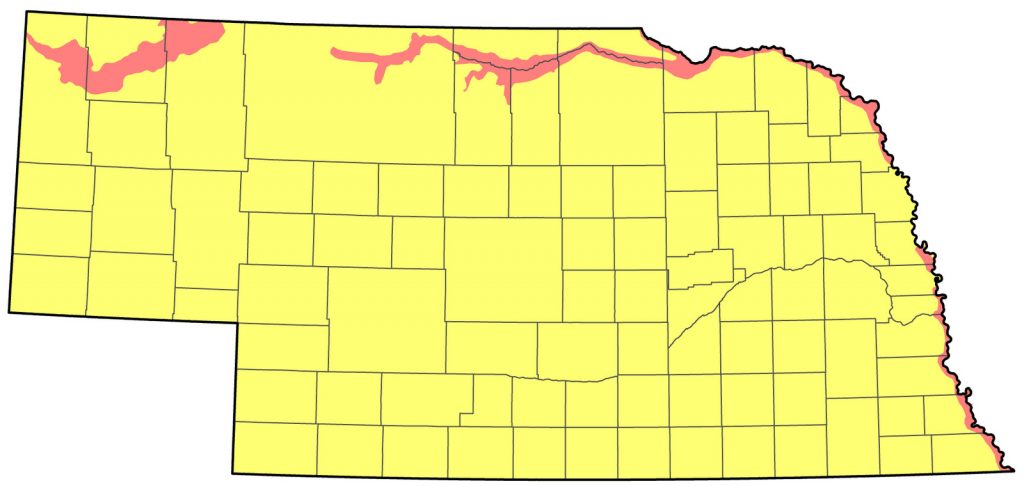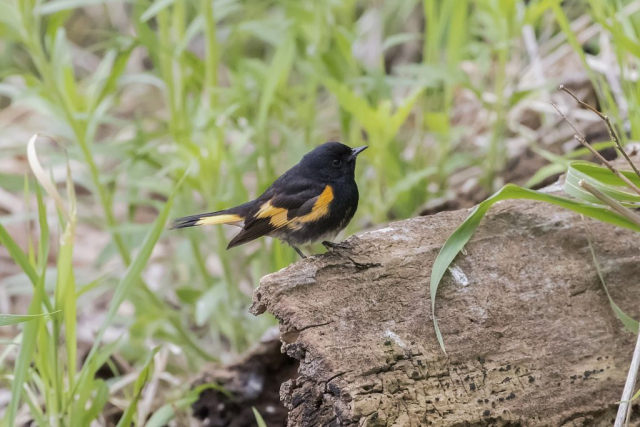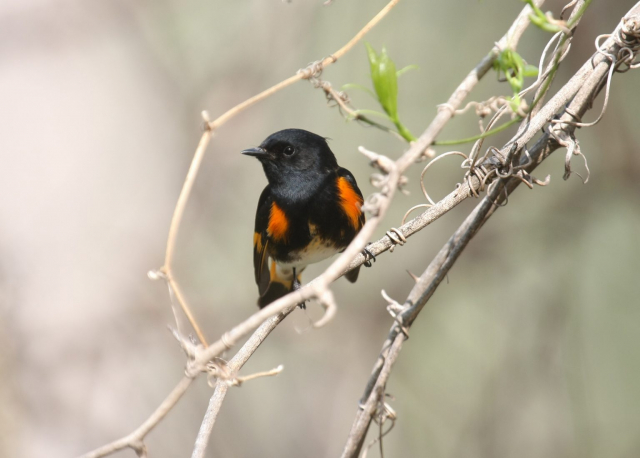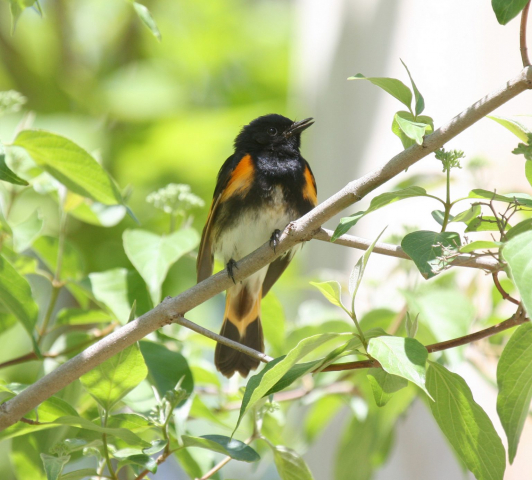Setophaga ruticilla
Status: Common regular spring and fall migrant east and central, uncommon west. Common regular breeder north, northwest, and east.

Documentation: Specimen: UNSM 6917, 18 Jun 1902 Springview Bridge, Keya Paha Co.
Taxonomy: No subspecies are recognized (AviList 2025).
Spring: Apr 26, 27, 27 <<<>>> Jun 21, 21, 21
Later dates away from known breeding areas are 25 Jun 2017 Lancaster Co, 25 Jun 2021 Dodge Co, and 25 Jun 2025 Lake Ogallala, Keith Co, 3 Jul 2025 Lancaster Co, 5 Jul 2024 Pawnee Co, 6 Jul 2022 Lincoln Co, 6 Jul 2025 Buffalo Co, and 6 Jul 2025 Stanton Co, and 9 Jul 2025 Keith Co.
For later Jul dates, see Fall, below.
Migration takes place in late Apr and May. Jun and early Jul reports away from breeding areas may be of straggling one-year-olds; only about 50% of one-year-old males breed successfully (Sherry et al 2020).
- High counts: 150 (88 wetlands, 62 uplands) at Fontenelle Forest 13 May 2021, 100 there 15 May 2016, 80 there 22 May 2019, and in the west 46 at Sowbelly Canyon, Sioux Co 28 May 2001.
- A total of 1075 were reported in spring 2021 and 1706 in 2023, the latter enhanced by Birding Bowl competitive activities.
Summer: The current breeding range of this species is restricted to discontinuous forested areas along the east and north edges of the state. Although this range has not changed much in extent since Short (1961) described it, American Redstart may have been at one time more widely distributed. Around 1900, it was considered an “abundant breeder and summer resident over the state” (Bruner et al 1904), and as recently as 1958, Rapp et al (1958) listed it as a “common migrant and summer resident throughout the state.” By 1980 (Johnsgard 1980), the range was restricted to the Missouri and Niobrara River Valleys and the Pine Ridge, with a few scattered summer records elsewhere. Between the first and second BBAs (Mollhoff 2001, 2016), the range changed little in extent, but the number of overall reports increased, especially in the eastern Niobrara River Valley west to central Cherry Co.
Both BBAs showed several Pine Ridge reports, including two in Sheridan Co (Mollhoff 2001, 2016). Rosche (1982) thought it a fairly common summer resident in Sioux and Dawes Cos; nests were found in Sowbelly Canyon 16 Jun 1986 (Huser 1986) and West Ash Canyon, Dawes Co, 12 Jun 1999 (Mollhoff 2001). One was at Box Butte Reservoir, Dawes Co 25 Jun 2023.
There are a few suggestive reports from Scotts Bluff Co, where a pair was found 9 Jul 1999 and at least one remained near Scottsbluff until early Jul 2000. Another returned to its “summering spot” in Scotts Bluff Co in 2005, a pair was in a northwest Scottsbluff yard 31 May into Jun 2008, one was at Lake Minatare 12 Jun 2014, and a “young” bird was there 7 Aug 2012. One was at Buffalo Creek, Banner Co 23 Jun 2023.
Brogie and Mossman (1983) found several singing males in the Niobrara Valley Preserve in 1982, suggesting that it was a probable nester there. It was reported from Valentine NWR, Cherry Co 16 Jul 1994, 24 Jun 2018, and singles were at three locations there 12-21 Jun 2023. In 2008, “numerous pairs” were found Jun-Jul in Holt, Keya Paha, Brown, and Cherry Cos (Silcock 2008). Nine at Long Pine SRA, Brown Co 10 Jul 2023 and one at Keller Park SRA, Brown Co 27 Jun 2023 suggest breeding there. Singles were near Bassett, Rock Co 4 Jul 2024 and Atkinson, Holt Co 5 Jul 2024.
There are reports in the northeast close to the breeding range at O’Neill, Holt Co 15 Jun 2011, at Grove Lake, Antelope Co 26 Jun 2018, 27 Jun 2021, and 23 Jul 2023, in Madison Co 26 Jun 2011, Pierce Co 2 Jul 2024, Stanton Co 1 Jul 2012, 30 Jun 2024, and 6 Jul 2025, near Wisner, Cuming Co 6 Jul 2022, and at Oak View Park, Knox Co 1 Aug 2024. The westernmost report in the Niobrara River Valley is of two birds at Anderson Bridge WMA, Cherry Co 19 Jun 2014; a “fantastic density” of 32 birds was reported there 5 Jun 2023, likely including migrants.
There is no evidence for breeding in the Loup drainage since Ford (1959) found it to be a common breeding bird in Thomas Co and Short (1961) found it common at NNF Bessey; Bray (1994) found no evidence of breeding there in 1993.
One at Fort Falls, Cherry Co 18 Jun 2021 was singing a song with a rise in pitch evocative of a Northern Parula’s song but with a somewhat slower trill (Jen Corman, eBird.org).
- Breeding phenology:
Nest building: 18 May-16 Jun
Eggs: 29 May-29 Jun (Mollhoff 2022)
Nestlings: 11 Jun-8 Jul
Fledglings 27 Jun-27 Jul
- High counts: 57 at Fontenelle Forest, Sarpy Co 7 Jun 2019, 49 there 26 Jun 2022, and 34 at Indian Cave SP, Richardson Co 12 Jul 2020.
Fall: Aug 9, 9, 10 <<<>>> Oct 3, 4, 5
Early dates above are away from breeding areas, and indicate the onset of true migration, which takes place mid-Aug through early Oct. There is a gradual early departure from the breeding grounds beginning in Jul, however (Sherry et al 2020), and there are these dates that fit that pattern: 11 Jul 1992 banded Keith Co (Brown et al 1996), 11 Jul 2013 (4) Saunders Co, 12 Jul 2019 Merrick Co, 15 Jul 2010 Frontier Co, 15 Jul 2012 Lancaster Co, 15 Jul 2019 Lancaster Co, 16 Jul 2020 Buffalo Co, 18 Jul 2020 Dundy Co, 20 Jul 2023 Jefferson Co, 21 Jul 2015 in Jefferson Co, 29 Jul 2010 Keith Co, 29 Jul 2010 Morrill Co, 3 Aug 2019 Colfax Co, and 5 Aug 1982 McPherson Co.
Later dates are 13 Oct 1999 Otoe Co, and one photographed 29 Oct 2018 North Platte, Lincoln Co.
- High counts: 13 at Walnut Grove Park, Omaha, Douglas Co 10 Sep 2018, 13 at Rock Creek SRA, Dundy Co 29 Aug 2020, 12+ at Krimlofski Tract, Neale Woods, Washington Co 13 Sep 1998, 12 in Sowbelly Canyon, Sioux Co 24 Aug 2019, 12 at Valentine, Cherry Co 9 Sep 2022, and 12 at Fontenelle Forest, Sarpy Co 28 Aug 2024.
Images
Abbreviations
BBA: Breeding Bird Atlas
NNF: Nebraska National Forest
NWR: National Wildlife Refuge
SP: State Park
SRA: State Recreation Area
UNSM: University of Nebraska State Museum
WMA: Wildlife Management Area (State)
Literature Cited
AviList Core Team, 2025. AviList: The Global Avian Checklist, v2025. https://doi.org/10.2173/avilist.v2025.
Bray, T.E. 1994. Habitat utilization by birds in a man-made forest in the Nebraska Sandhills. M.S. thesis, University of Nebraska-Omaha.
Brogie, M.A., and M.J. Mossman. 1983. Spring and summer birds of the Niobrara Valley Preserve, Nebraska: An annotated checklist. NBR 51: 44-51.
Brown, C.R., M.B. Brown, P.A. Johnsgard, J. Kren, and W.C. Scharf. 1996. Birds of the Cedar Point Biological Station area, Keith and Garden Counties, Nebraska: Seasonal occurrence and breeding data. Transactions of the Nebraska Academy of Sciences 23: 91-108.
Bruner, L., R.H. Wolcott, and M.H. Swenk. 1904. A preliminary review of the birds of Nebraska, with synopses. Klopp and Bartlett, Omaha, Nebraska, USA.
Ford, N.L. 1959. Notes on summer birds of western Nebraska. NBR 27: 6-12.
Huser, B.F. 1986. June notes for western Nebraska. NBR 54: 82-83.
Johnsgard, P. A. 1980. A preliminary list of the birds of Nebraska and adjacent Great Plains states. Published by the author, University of Nebraska, Lincoln, USA.
Mollhoff, W.J. 2001. The Nebraska Breeding Bird Atlas 1984-1989. Nebraska Ornithologists’ Union Occasional Papers No. 7. Nebraska Game and Parks Commission, Lincoln, Nebraska, USA.
Mollhoff, W.J. 2016. The Second Nebraska Breeding Bird Atlas. Bull. Univ. Nebraska State Museum Vol 29. University of Nebraska State Museum, Lincoln, Nebraska, USA.
Mollhoff, W.J. 2022. Nest records of Nebraska birds. Nebraska Ornithologists’ Union Occasional Paper Number 9.
Rapp, W.F. Jr., J.L.C. Rapp, H.E. Baumgarten, and R.A. Moser. 1958. Revised checklist of Nebraska birds. Occasional Papers 5, Nebraska Ornithologists’ Union, Crete, Nebraska, USA.
Rosche, R.C. 1982. Birds of northwestern Nebraska and southwestern South Dakota, an annotated checklist. Cottonwood Press, Crawford, Nebraska, USA.
Sherry, T.W., R.T. Holmes, P. Pyle, and M.A. Patten. 2020. American Redstart (Setophaga ruticilla), version 1.0. In Birds of the World (P. G. Rodewald, Editor). Cornell Lab of Ornithology, Ithaca, NY, USA. https://doi.org/10.2173/bow.amered.01.
Short, L.L., Jr. 1961. Notes on bird distribution in the central Plains. NBR 29: 2-22.
Silcock, W.R. 2008. Summer Field Report, June-July 2008. NBR 76: 94-111.
Recommended Citation
Silcock, W.R., and J.G. Jorgensen. 2025. American Redstart (Setophaga ruticilla). In Birds of Nebraska — Online. www.BirdsofNebraska.org
Birds of Nebraska – Online
Updated 1 Sep 2025



